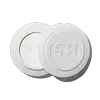Simihaze Beauty Soft Blur Moisture-Lock Setting Powder Versus Majolica Majorca Amulet Veil Acne & Pore
What's inside
What's inside
 Key Ingredients
Key Ingredients

 Benefits
Benefits

 Concerns
Concerns

 Ingredients Side-by-side
Ingredients Side-by-side

Stearyl Glycyrrhetinate
Skin ConditioningTocopheryl Acetate
AntioxidantSodium Hyaluronate
HumectantMelaleuca Alternifolia Leaf Extract
PerfumingTalc
AbrasivePolyacrylate-2
Paraffinum Liquidum
EmollientPetrolatum
EmollientGlyceryl Ethylhexanoate
EmollientPEG-8 Dimethicone
EmulsifyingPhthalic Anhydride
Sorbitan Sesquiisostearate
EmulsifyingCalcium Stearate
Cosmetic ColorantChlorphenesin
AntimicrobialMagnesium Silicate
AbsorbentDistearyldimonium Chloride
Glycerin
HumectantWater
Skin ConditioningTocopherol
AntioxidantAlcohol Denat.
AntimicrobialCitric Acid
BufferingDisodium Phosphate
BufferingSynthetic Fluorphlogopite
Mica
Cosmetic ColorantCI 77120
Cosmetic ColorantCI 77491
Cosmetic ColorantCI 77492
Cosmetic ColorantTitanium Dioxide
Cosmetic ColorantCI 77499
Cosmetic ColorantStearyl Glycyrrhetinate, Tocopheryl Acetate, Sodium Hyaluronate, Melaleuca Alternifolia Leaf Extract, Talc, Polyacrylate-2, Paraffinum Liquidum, Petrolatum, Glyceryl Ethylhexanoate, PEG-8 Dimethicone, Phthalic Anhydride, Sorbitan Sesquiisostearate, Calcium Stearate, Chlorphenesin, Magnesium Silicate, Distearyldimonium Chloride, Glycerin, Water, Tocopherol, Alcohol Denat., Citric Acid, Disodium Phosphate, Synthetic Fluorphlogopite, Mica, CI 77120, CI 77491, CI 77492, Titanium Dioxide, CI 77499
Ingredients Explained
These ingredients are found in both products.
Ingredients higher up in an ingredient list are typically present in a larger amount.
Mica is a naturally occurring mineral used to add shimmer and color in cosmetics. It can also help improve the texture of a product or give it an opaque, white/silver color.
Serecite is the name for very fine but ragged grains of mica.
This ingredient is often coated with metal oxides like titanium dioxide. Trace amounts of heavy metals may be found in mica, but these metals are not harmful in our personal products.
Mica has been used since prehistoric times throughout the world. Ancient Egyptian, Indian, Greek, Roman, Aztec, and Chinese civilizations have used mica.
Learn more about Mica